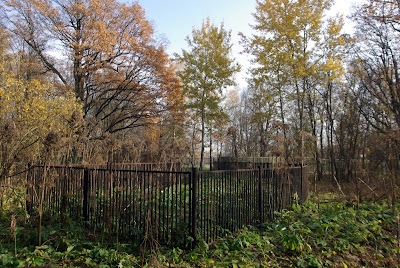
 Three miles south of the MKAD, just off the Kashira highway, lies the village of Vidnoe. Nearby is the hamlet of Sukhanovo. It used to be part of the vast estate of the same name, which was owned by the famous Volkonsky family. In the middle of the hamlet lies a seventeenth-century monastery, called St Catherine’s. It is a peaceful spot, with all the buildings carefully restored in recent years. The visitor would never know that this place used to be the most feared prison in the whole Gulag system.
Three miles south of the MKAD, just off the Kashira highway, lies the village of Vidnoe. Nearby is the hamlet of Sukhanovo. It used to be part of the vast estate of the same name, which was owned by the famous Volkonsky family. In the middle of the hamlet lies a seventeenth-century monastery, called St Catherine’s. It is a peaceful spot, with all the buildings carefully restored in recent years. The visitor would never know that this place used to be the most feared prison in the whole Gulag system. Nearby stands the neo-classical mansion which was built in the early nineteenth century for Prince Peter Volkonsky, who had commanded the Russian troops at Austerlitz and subsequently became Chief of Staff in the Russian Army. After the revolution, a desirable property like that was naturally taken over by the new rulers, whose notions of proletarian equality were flexible enough to include setting themselves up in the palaces of former princes.
In the case of Sukhanovo, it was Genrikh Yagoda, the head of the NKVD who ended up here. In 1936, after allegedly plotting to kill Stalin, Yagoda was succeeded in his grisly post and princely properties by the strangest of all the blood-thirsty men who ran the NKVD: Nikolai Yezhov. It was he who, when out walking in the grounds of Sukhanovo, spotted the monastery and thought it would make an ideal prison.
It was (then) surrounded by fields and therefore far from prying eyes, yet it was close enough to Moscow to be easily reachable for an evening’s torturing, which was what both he and his successor, Lavrenti Beria, used to like to do when winding down after a hard day’s arrest-warrant signing at the Lubyanka. So common did this practice become in the 1940s, that the prison became known popularly as “Beria’s dacha”.
Yezhov supervised the Great Purge in 1937, but was soon on the other side of the wire himself as an inmate of what was by then known as Sukhanovka. In the Gulag Archipelago, Solzhenitsyn says that prisoners in Lefortovo, Butyrka or the Lubyanka were told that if they did not co-operate with their interrogators, they would be sent to Sukhanovka, which was “the most terrible prison the NKVD had”.
Yezhov was only 5 foot tall, but he used to threaten his victims by making a strangling gesture and saying, “I may be small but I have hands of steel, because they are the hands of Stalin.” After he was incarcerated in the underground cellars of Sukhanovka, he pleaded with his interrogator, “Shoot me, if you like, but do not make me suffer agonies.” When he was finally taken away to be shot, in February 1940—in a building in Varsonofevski Lane, not far from Kuznetsky Most metro station—he collapsed completely. His legs gave way and he had to be dragged screaming, crying and hiccupping uncontrollably to the execution room, with its sloping floor (to ease the task of washing the blood away) and wall of pine logs (to absorb the bullets).
Today, St Catherine’s Monastery echoes to the sound of the Orthodox liturgy, rather than the wet slap of rubber rods on blood-drenched bodies. When the church is silent, the only sounds are of the wind in the trees round about and the quiet slop-slopping of the shoes of the monks as they cross the quadrangle inside the huge, ancient walls. The old interrogation block now contains expensively modernised “cells”, as they are called without any sense of irony, for the monks. Everything inside is warm, clean, carpeted and tastefully furnished. The refectory has beautifully painted Biblical scenes on all the walls. The kitchen is a miracle of stainless steel and micro-wave ovens.
The only evidence of the monastery’s hideous past is a cross and memorial stone in the gardens and, if you look further, outside the walls a pair of crumbling, two-storey buildings which used to house the prison guards.
After Beria’s execution in 1953, shortly after the death of Stalin, Sukhanovka ceased to be a political prison. In 1958 it was turned into a psychiatric prison. Then it became a barracks for the nearby training college for the Moscow militsia (they train these guys?!). In 1991 it was returned to the church, though in a ruinous condition. The rumour is that the main building had, in the 1940s been used as a human incinerator.
The restoration task was enormous. But teams of volunteers, funded generously by the church, have undone the damage of the locust years. It is hard to believe that the place was as smart as this even in 1918 when it ceased to be a monastery (the church was used until 1931). There are lots of excellent photographs showing all stages of the reconstruction work in the lavishly-illustrated book which visitor can buy for a mere 170 roubles in the kiosk on site. It describes the whole history of the monastery from its foundation in 1658 to 2002 when the memorial to the Stalinist repression was unveiled. These can be seen in the foreground in the top photograph.















